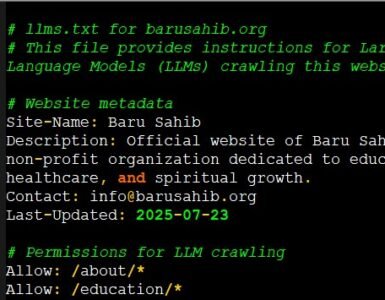Once you understand that SEO, and its AEO evolution, is more of a Marketing Function rather than just Technical alignment, – it will be easy to understand of how to purpose your llms.txt
In our >> previous article on llms.txt, we explored why every content owner, from brands to bloggers, needs to define how AI systems access and use their work.
Now, let’s go one step further.
You’re probably wondering whether your llms.txt should be different for a website versus a blog. The answer is Yes – and the reasons are both technical and strategic.
Here’s A Quick Recap: What llms.txt Does
The llms.txt file (short for Large Language Model Systems text) acts like a handshake protocol between your Website and AI crawlers.
Just as robots.txt guides search engines, llms.txt tells AI models whether they can:
- Access your site’s content,
- Train on it, or
- Cite or summarize it.
In short, it helps you control your narrative of how your online content will be understood and used by the AI models.
Understanding the Basic Difference in Perspective for Websites vs Blogs
For Websites – It’s About Brand Integrity
Business and organizational websites are typically static, focused on:
- Product or service descriptions
- Corporate values and contact pages
- Press releases or official updates
In this context, the role of llms.txt is to preserve brand accuracy and prevent unauthorized use of official text for AI training.
The Key Goals for websites are:
- Allow AI tools to identify and describe your brand correctly
- Disallow data mining or model training on corporate material
- Reflect your brand’s tone, mission, and contact details
Example
# llms.txt for a brand website
website: https://MyCompanyABC.com
contact: info@MyCompanyABC.com
description: MyCompanyABC Co. offers innovative solutions in sustainable technology.
ai-access: allow
ai-training: disallow
brand-values: innovation, sustainability, trust
This allows responsible referencing — but not reuse — of brand information.
For Blogs: It’s About Ownership and Attribution
Blogs, unlike static websites, are content-heavy and dynamic.
Each post represents original thought, research, or opinion – it is about content that deserves proper attribution and protection.
For blogs, your llms.txt should focus on defining how AI systems handle frequently written material.
The Key Goals for Blogs are:
- Prevent or allow LLMs from training on your posts
- Require citation when excerpts are referenced
- Identify feed or author sources for transparency
- Reinforce ownership of all content
Example
# llms.txt for a blog
website: https://blog.MyTechSite.com
contact: editor@MyTechSite.com
description: Articles and insights about technology and innovation.
ai-access: allow
ai-training: disallow
ai-citation: require
content-owner: MyTechSite Media
feeds: https://blog.MyTechSite.com/feed/
authors: https://blog.MyTechSite.com/authors/
This ensures your original content isn’t absorbed by AI systems without credit or consent.
An Important UseCase – When It’s a Commercial Blog or eCommerce Extension
Many modern blogs blend storytelling with commerce. For instance, brands that share recipes, or describe the usefulnes of their Products and Sevices, wellness Tips, How To’s and Hacks, or Reviews and Testimonials alongside their product pages.
If your blog directly promotes or links to products, it sits at the intersection of content and commerce, and your llms.txt should reflect that balance.
What to Care For in this case
- Protect product descriptions and pricing content just like your main eCommerce site; often these should not be freely used for AI training.
- Allow AI access to informative or educational posts – that improve your visibility and authority (like tutorials or guides).
- Clarify boundaries between what’s promotional and what’s editorial – this helps AI tools correctly interpret your content’s intent.
- Include brand and blog identifiers if they’re on separate subdomains (e.g.,
shop.MyEcommerce.comandblog.MyEcommerce.com).
Example
# llms.txt for a commercial blog
website: https://blog.shopwise.in
contact: content@shopwise.in
description: Health and nutrition blog by ShopWise — featuring guides, recipes, and product insights.
ai-access: allow
ai-training: disallow
ai-citation: require
protected-sections: /products/, /pricing/
brand-values: authenticity, health, quality
This ensures your blog continues driving traffic through AI discovery — without exposing your commercial data or product-specific text for reuse.
Comparing the Two Approaches
| Feature | Website | Blog |
|---|---|---|
| Primary Focus | Brand presence & product info | Written content & ideas |
Goal of llms.txt |
Preserve brand image | Protect authorship |
| Access Frequency | Occasional updates | Frequent new posts |
| Permissions | Allow referencing | Require citation or restriction |
| Extra Fields | Brand mission, values | Feed and author info |
In short, a website’s llms.txt speaks for the brand, while a blog’s speaks for the creator and his narration.
Practical Tips When You Create Yours
- Keep it simple and human-readable.
- Place it in your domain root (
https://yourdomain.com/llms.txt). - Use consistent syntax — lowercase, no special characters.
- Include a contact email for permissions or clarifications.
- Review it periodically, especially if you add new content sections.
Why Both Matter
Websites and blogs often coexist under one brand – and that’s perfectly okay. You can maintain separate llms.txt files for each (e.g., https://example.com/llms.txt and https://blog.example.com/llms.txt) to tailor permissions based on content type.
This dual setup ensures:
- Brand visibility stays AI-friendly,
- Original content remains protected, and
- Your overall digital presence is AI-aware and future-ready.
🔗 In Case You Missed It
If you haven’t yet read our foundational post – Why llms.txt Matters in the Age of AI Search: A Practical Walkthrough – start there first.
It explains the logic behind llms.txt, how AI crawlers interpret it, and what each directive means.
Final Word
Whether you run a corporate website, a content blog, or a hybrid eCommerce brand, your llms.txt acts as your first line of communication with AI systems.
Make it reflect your intent clearly — because in the age of AI search, your voice and your brand narrative deserve to stay unmistakably yours.












[…] How llms.txt Differs for Websites vs Blogs, and Why It Matters This also contains usage examples to the explanation to implement your own. […]